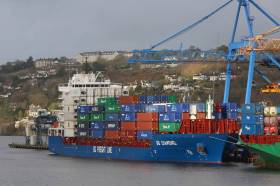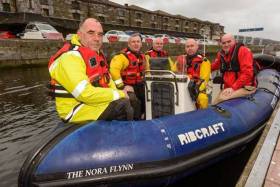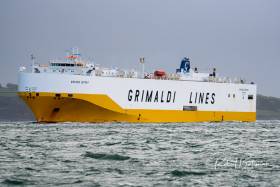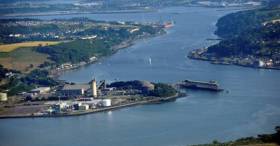Displaying items by tag: port of Cork
St Columbas Girls National School Win ‘Best Overall Project’ in the Port of Cork Schools Initiative 2019
Port of Cork Chairman, Mr. John Mullins congratulated St Columbas Girls National School for being awarded ‘Best Overall Project’ in the Port of Cork Schools Initiative 2019. Scoil Barra Naofa, Monkstown were given special recognition for their outstanding level of research and content used in their project.
The Port of Cork have been running their primary schools initiative for 13 years now and 2019 was the first year that Port of Cork teamed up with MaREI, the UCC research Centre for marine and renewable energy based in Ringaskiddy, to deliver this educational initiative around marine litter.
Themed ‘Maintaining a Healthy Harbour’ the initiative educated school children on marine litter and the detrimental effects it can have on our oceans, harbour and shorelines. Over twenty schools took part and with the help of MaREI, classes were encouraged to collect and use marine litter and recycled items to create a 3D art project that makes people stop and think.
John Mullins said: ‘All the schools that participated in this year’s initiative can feel proud of their efforts as the projects submitted were incredibly visual and would certainly make people stop and think about the effects of marine litter.’
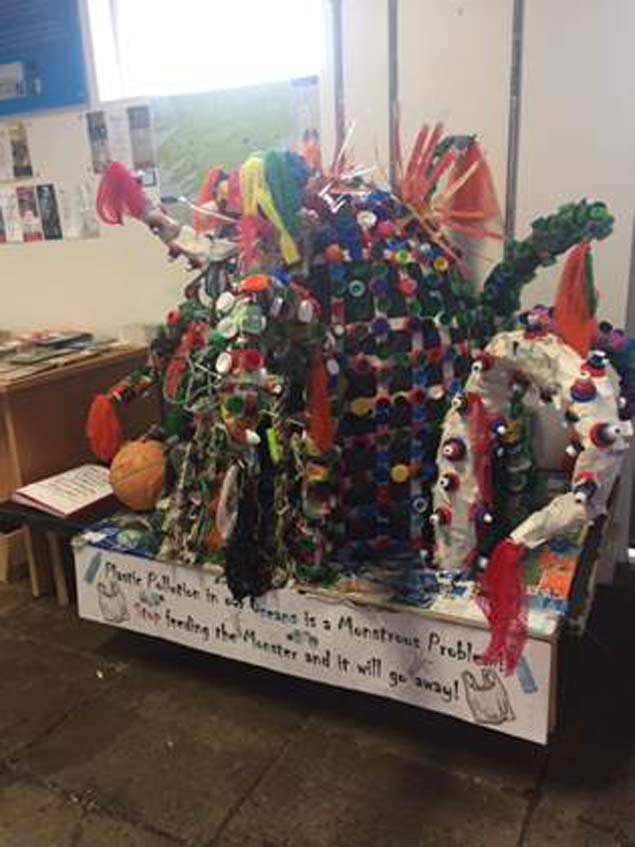 St Columbas Girls National School’s ‘Plastic Monster’
St Columbas Girls National School’s ‘Plastic Monster’
He told the children they are our future and said: ‘It is the younger generation, like yourselves that will make the difference and you are an inspiration for us all.’
The Port of Cork were joined by Aoife Deane from MaREI and Susan Vickers from Clean Coasts who both judged the projects.
Researchers estimate that over 10 million tonnes of litter ends up in the world’s oceans each year and 1 million seabirds and 100,000 marine mammals (seals, whales, dolphins) die every year because of marine litter through entanglement or ingestion. There is a growing public awareness of the issue, and with almost half of all marine litter being made up of just 10 types of single-use plastic items, we can take steps to tackle the problem.
Port of Cork Chairman John Mullins reminded all participating classes that as well as receiving a certificate of participation, every class will be treated to a high speed, fun filled boat trip around Cork Harbour, compliments of the Port of Cork. As an extra special prize, best overall winners St Columbas Girls National School will go on board a cruise liner in May for a tour of the ship.
All school projects are currently on display at the Cobh Maritime Building, located on the platform at Cobh Railway Station until the end of May.
As part of Cork Harbour Festival and Seafest the projects will be on display to the public in Custom House, Cork City from 1st – 9th June 2019.
The Port of Cork and its partners were ‘highly commended’ at last night’s Seatrade Awards in the ‘Deal of the Year’ category in recognition of its work in securing significant funding for the development of the new Cork Container Terminal (CCT) in Ringaskiddy, which will open in 2020.
The funding for the €80m project was secured from a combination of sources including the Allied Irish Banks p.l.c (AIB), the European Investment Bank (EIB), and the Ireland Strategic Investment Fund (ISIF), as well as EU Connecting Europe Facility funds, and self-finance. €1m of the total capital secured is allocated to a community gain fund for the Ringaskiddy area.
The deal represents a major commitment and pan-European belief in the future of the Irish maritime sector and took two years to complete. It puts in place an innovative transaction structure involving senior debt from AIB and EIB and junior debt from ISIF. As a key infrastructure deal, the project will increase future capacity at the port and bring major strategic value to the city of Cork and the wider Munster region, as well as the overall Irish economy.
Established in 1989, the Seatrade Awards recognise shipping's most impressive innovations and achievements. Throughout its 30-year history, the Awards have provided a reliable benchmark for success, the trends affecting the maritime world, and celebrating those who are driving the industry forward.
The Port of Cork was recognised by the EU as a ‘core’ port on the North Sea Mediterranean Corridor, and identification by the Irish Government as a Tier 1 Port. Secured through an innovative financing structure, the funding arrangement represents the most significant single investment in marine infrastructure and superstructure in the 200-year history of the Port of Cork.
Donal Crowley, Chief Financial Officer & Deputy CEO of the Port of Cork commented: “The Port of Cork's natural deepsea harbour and geography makes it ideally placed to enhance trade between Ireland and the rest of the world. But no matter how necessary the move to expand the port was from a strategic perspective, securing funding for the project was a huge challenge, and we must credit our finance team at the Port, and all our finance partners for arranging this innovative deal.
“The deal not only secures the Port’s legacy and delivers a 21st century terminal but cements a bright future in terms of the Port’s growth to benefit the local Cork area and the wider Munster region economically.”
The CCT redevelopment is a Strategic Trans – European Transport Network (TEN-T) project, recognising the Port of Cork’s significant growth potential. The first phase of this development provides critical replacement facilities for the Tivoli Container Terminal and will initially span a 360-metre quay with 13 metre depth alongside; initially enabling vessels of up to 4,000 TEUs berth.
The development includes the construction of a 13.5 hectare ‘greenfield’ terminal, serviced by modern and efficient cargo handling equipment, with innovative terminal operating and vehicle booking systems.
Cork's Tivoli Redevelopment Updated Designs Are Considered
#waterfrontproperty - EchoLive reports of updated design plans in Cork for the redevelopment of the Tivoli docklands that were discussed at a recent meeting in City Hall.
At the Planning Strategic Policy Committee (SPC), officials outlined the proposed development that would see more than 10,000 people living and working in Tivoli.
The Port of Cork is set to vacate the site in the next two years, and plans to create an urban area the size of Blackrock are being prepared.
According to City Hall, Government funding under the Local Infrastructure Housing Activation Fund (LIHAF) to develop the area has been secured.
While Cork City Council does not own the land itself, it is supportive of projects to enhance the city.
More on this story can be read from this link.
2019 Will Be a Record Year for Port of Cork Cruise Calls
The first of 102 cruise liners MV Astoria will arrive into Cobh on Monday 1st April and officially commence the Port of Cork’s 2019 cruise season. Without doubt, 2019 will be a record year for the Port of Cork with the numbers of scheduled calls the highest the port has ever seen. Capable of handling some of the largest liners, carrying high volumes of passengers at their dedicated cruise berth in Cobh, the Port of Cork anticipates total passenger numbers to be 200,000 and 80,000 crew.
Fourteen cruise liners will make their maiden calls to the Port this season which is always encouraging, however, the number of repeat visits from cruise lines shows their dedication to Cobh.
The increased cruise calls to Cork are indicative of the wider global cruise business which has seen huge growth. In 2018 an estimated 27.2 million people took a cruise on over 450 cruise ships worldwide. With the global cruise ship order book for new build contracts reaching 113 ships between now and 2027, Cork cruise business is set to grow further in the coming years and the Port of Cork is eager to attract these new ships.
According to Conor Mowlds, Port of Cork Chief Commercial Officer, and recently appointed Chairman of Cruise Ireland, Cork’s profile has been raised significantly in recent years, due to a series of glowing reports in some of the world’s leading cruise travel journals. Surveys report a high degree of satisfaction among visitors with the regions natural amenities proving especially popular. Joined up thinking and collaboration of local authorities and tourism representatives working to promote the area has also greatly benefited the region.
Mr Mowlds said: “It is not as difficult to sell Cork as it was ten years ago and there is a much wider recognition of the Cork brand globally especially since the launch of the We Are Cork and Pure Cork brands. As we know, in order to successfully promote a city, it requires hard work from all parties involved and we will continue to work with Cork City and Cork County Council to promote and enhance the reputation of Cork globally.’
On average, cruise ship passengers spend €81 during their time in Cork; with 42% of this money being spent on shopping, 32% on excursion travel and 17% on food and drink. Typically crew spend approximately €29, with most of the money being spent on food and drink and/or shopping.
As well as Cobh the Port of Cork also operates Bantry Bay Port Company which will see ten cruise liners calling to the West Cork area this summer. Bantry Harbour and Glengarriff can accommodate the smaller boutique cruise liners whose passengers tend to look for active expedition cruises. Bantry Bay Port Company and the Port of Cork are currently developing a cruise strategy for Bantry in order to grow the business in West Cork.
The Cork City Missing Persons Search and Recovery (CCMPSAR) voluntary group recently took ownership of a second boat. The 5.8m RIB will be based at the Port of Cork City Marina and is fitted with side scan sonar, which will greatly assist in river searches.
CCMPSAR Chairman Edwin O’Sullivan said: ‘We named the boat ‘The Nora Flynn’ after the late Nora Flynn, chosen by Nora's nephew Dinny Kiely, who is also one of our longest serving volunteers. It is a great honour and a fitting tribute to name the boat after Nora and to also have so many of her family present on the day of the launch.’
The RIB was generously funded by a number of supporters such as Port of Cork, Irish Mainport Holdings, Lehane Environmental & industrial Services Ltd, CH Marine, Whelan Stores, Inver and Jotun (Ireland) Ltd.
Port of Cork Increase Leisure Boat Charges in Cork Harbour
Boat owners in Cork Harbour, receiving their renewal bills for moorings and for the use of the harbour by their boats are being hit with increased charges by the Port of Cork.
The port has increased the cost of having a mooring in the harbour from €95 to €100 per year and increased the cost of a boat using the harbour also.
For a 33-foot boat, the charge has been increased also by €5 from €95 to €100.
Agri Food Imports Boost Port of Cork Traffic in 2018
The Port of Cork reports total traffic through both the Port of Cork and Bantry Bay Port Company reached 10.6 million tonnes in 2018, an increase of 3% compared to 2017. Total imports increased by 8% while exports increased by 5%. The most growth was seen in the agri-food sector such as animal feed, fertilizers and cereals which increased by 39% over the year.
Oil traffic handled through Whitegate Oil Refinery owned by Canadian company Irving Oil saw an increase of 4%. Total container volumes through both Tivoli and Ringaskiddy Container Terminals grew by 6% compared to 2017 figures, with a total of 229,762 TEU’s handled in 2018.
In 2018 the Port of Cork handled 95 cruise liners bringing over 157,000 passengers and crew to the region, while Bantry Bay Port Company welcomed 10 cruise liners to the harbour town.
Brendan Keating, Chief Executive said: ‘2018 saw the most growth in Agri-food imports which rose by 39% compared to last year. This increase will have a positive effect on the volumes Munster can export, underpinning Ireland as a major food-exporting nation. However, approximately three-quarters of exports go to markets in the UK and the EU, with the balance going to the rest of the world. So with Brexit looming, this is an area we will be keeping a close eye on in terms of trade agreements.’
He continued: ‘In 2018 the Port of Cork marked a major milestone with the launch of the new €80 Million Cork Container Terminal development in Ringaskiddy, so, therefore, we were particularly encouraged by the growth in container traffic with volumes through both Tivoli and Ringaskiddy Container Terminals up by 6% compared to 2017. We also saw key growth in our cruise business with 95 cruise ships visiting. This was the most significant cruise season ever for the Port of Cork with over 157,000 passengers and 69,000 crews stepping ashore this summer.’
While Brexit is drawing nearer, the Port of Cork has much to be positive about and in 2019 the Port expects to see further growth in traffic. A record 104 cruise ships are scheduled to call which will bring over 200,000 visitors to the region. The construction of Cork Container Terminal is underway and is envisaged to be operational by 2020, thus securing the need for growth in the region. The new RoPax ferry service from Cork to Santander operated by Brittany Ferries has reported a steady increase in the number of freight units using the route, with hauliers choosing this route to avoid the UK land bridge option.
Port of Cork & MaREI Team Up to Deliver A Primary Schools Initiative For A Healthy Harbour
For the last 13 years the Port of Cork has delivered a schools initiative to 5th class primary schools across Cork City and County, with a particular focus on the harbour area. For the first time this year, the Port of Cork has teamed up with MaREI, the UCC research centre for marine and renewable energy based in Ringaskiddy, to deliver an educational initiative around marine litter.
Port of Cork and UCC team up to highlight the issue of marine litter through their primary school's initiative. Fact; Plastic bags are often mistaken for jellyfish and eaten by marine life.
Aoife Deane UCC and Sara Mackeown Port of Cork with Caomihe Mc Sweeney, Emily Rose and Caoimhe Ni Bheara of Scoil Bhríde Crosshaven Co Cork pictured with their 'Bloom of Plastic Jelly Fish'.
"Plastic bags are often mistaken for jellyfish and eaten by marine life"
Themed ‘Maintaining a Healthy Harbour’ the initiative aims to make school children aware of marine litter and the detrimental effects it can have on our oceans, harbour and shorelines. With the help of MaREI, classes are encouraged to collect and use marine litter and recycled items to create a 3D art project that will make people stop and think. Researchers estimate that over 10 million tonnes of litter ends up in the world’s oceans each year and 1 million seabirds and 100,000 marine mammals (seals, whales, dolphins) die every year because of marine litter through entanglement or ingestion. There is a growing public awareness of the issue, and with almost half of all marine litter being made up of just 10 types of single-use plastic items, we can take steps to tackle the problem.
Port of Cork Chief Executive Mr Brendan Keating said: ‘Our schools Initiative has gone from strength to strength and this year are we delighted to partner with MaREI. They have great expertise in this area and their guidance in shaping the theme has been invaluable.’
He continued: ‘The issue of marine litter is apparent in all harbours and it is so important that school children recognise the impacts marine litter can have on a harbour both in and out of the water. As well as being educational, our initiative is fun and children have a great opportunity to be creative. I would strongly encourage primary schools in Cork to take part in this initiative.’
MaREI’s Communications and Public Engagement Manager, Aoife Deane, commented: ‘We are delighted to be collaborating with Port of Cork on their long established outreach initiative highlighting the value of our harbour. The ‘Healthy Harbour’ theme encourages students to think about the sources and impact of marine litter, and our reliance on single use plastics. And the exhibition of their artwork is an opportunity to highlight these issues to a wider audience.’
Each year the Port of Cork has over 30 schools from both Cork City and county participating in the Schools Initiative and they hope that this year will be no different.
All 5th classes who take part in the Port of Cork Schools Initiative will be treated to a boat trip around Cork harbour, compliments of the Port of Cork and each class will also receive a certificate of participation. The overall ‘Best Project’ will receive a tour on board one of the many luxurious cruise liners visiting Cork during the summer of 2019.
All submitted projects will go on public display in the Cobh Maritime Development building before the winner is announced in May 2019. Closing date for entries is Friday 12th April 2019.
If you would like more information on the Port of Cork Schools Initiative or would like to register your school, please contact Sara Mackeown, Port of Cork, email [email protected] or call 021 4625375.
Plans In Cork Harbour to Start Marino Point Redevelopment
#PortofCork - Chairman of the Port of Cork, John Mullins, hopes that activity can return to the long-idle Marino Point within two years, bringing valuable jobs to the area.
As The Evening Echo writes, since the former IFI plant closed, in 2002, with the loss of 220 jobs, the jetty (except for a recent Naval visitor) and other faclities have lain idle for years.
The Port of Cork led a consortium to buy it and, since the deal was finalised, in 2017, there has been significant interest in the project.
“We are working on the new masterplan for Marino Point,” Mr Mullins said. “We have parcels of land there and various people looking at them and we will be presenting a masterplan to Cork County Council of various tenants that intend to go in there.”
The Marino Point jetty is located in ten metres of water, enabling large ships to dock there, and the plan is for it to be used as a bulk terminal for products like agrifeed and fertiliser.
More on the story can be read here.
Cruiseships Record of 103 Call Visits to Cork Harbour in 2019
#CruiseLiners - Cruiseliners are to set a record with 103 calls booked to visit Cork next year, reports BreakingNews.ie, including several which will dock in the port for the first time.
New ships such as Celebrity Cruises MV Celebrity Reflection and Ocean Cruises MV Scenic Eclipse, billed as a contender for the world's most luxurious cruise ship, will make their maiden visit to the deep water quay in Cobh, along with Holland American Lines MS Nieuw Statendam.
With one more cruise ship left to dock this year (Afloat identified as CMV's Marco Polo), the Port of Cork’s 2018 cruise season is drawing to a close.
In total 92 cruise ships will have visited in 2018, which represents the most significant cruise season ever for the Port of Cork.
More than 157,000 passengers and 69,000 crew will have stepped ashore, boosting the local economy by an estimated €12m.
For further reading on the cruise-sector calling to Cork Harbour, click here.





























